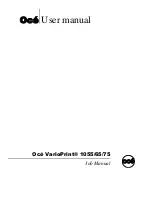
OPERATION GUIDE
Appendix-13
Smoothness
The paper surface should be smooth, but it must be uncoated. With paper that is too smooth and slippery,
several sheets may accidentally be supplied at once, causing jams.
Basis Weight
In countries that use the metric system, basis weight is the weight in grams of one sheet of paper one square
meter in area. In the United States, basis weight is the weight in pounds of one ream (500 sheets) of paper cut
to the standard size (or trade size) for a specific grade of paper. Paper that is too heavy or too light may be
supplied incorrectly or cause paper jams, which may cause excessive wear of the machine. Mixed paper weight
(i.e., thickness) may cause several sheets to be supplied at once accidentally and may also cause blurring or
other printing problems if the toner fails to adhere correctly.
The recommended basis weight is between 60 and 120 g/m
2
for the cassettes and between 60 and 220 g/m
2
for the multi purpose tray.
Thickness
Avoid using paper that is too thick or thin. Signs that paper may be thin include frequent problems with paper
jams or with several sheets being supplied at once. Paper jams may also indicate that the paper is too thick. The
proper thickness is between 0.086 and 0.110 mm.
Moisture Content
Paper moisture content is the ratio of moisture to dryness expressed as a percentage. Moisture affects how the
paper is supplied, the electrostatic changeability of the paper, and how the toner adheres.
Paper moisture content varies depending on the relative humidity in the room. High relative humidity causes
paper to become damp, making the edges expand so it appears wavy. Low relative humidity causes paper to
lose moisture, making the edges tighten and weakening print contrast.
Wavy or tight edges may cause the paper to slip when it is supplied. Try to keep the moisture content between
4 to 6%.
To maintain the right level of moisture content, bear in mind the following considerations.
• Store paper in a cool, well-ventilated place.
• Store paper flat and unopened in the package. Once the package is opened, reseal it if the paper is not to
be used for a while.
• Store paper sealed in the original package and box. Put a pallet under the carton to keep it raised above the
floor. Especially during rainy seasons keep the paper a sufficient distance away from wooden or concrete
floors.
• Before using paper that has been stored, keep it at the proper moisture level for at least 48 hours.
• Do not store paper where it is exposed to heat, sunlight, or dampness.
Other Paper Specifications
Porosity:
The density of the paper fibers
Stiffness:
Paper must be stiff enough or it may buckle in the machine, causing jams.
Summary of Contents for d-Copia 283MF
Page 1: ...OPERATION GUIDE d Copia 283MF d Copia 283MF Plus d Copia 284MF 551001en GB...
Page 30: ...xxviii OPERATION GUIDE...
Page 116: ...Basic Operation 3 34 OPERATION GUIDE...
Page 136: ...Copying Functions 4 20 OPERATION GUIDE...
Page 188: ...Status Job Cancel 7 22 OPERATION GUIDE...
Page 340: ...Default Setting System Menu 8 152 OPERATION GUIDE...
Page 348: ...Maintenance 9 8 OPERATION GUIDE...
Page 366: ...Troubleshooting 10 18 OPERATION GUIDE...
Page 436: ...Index 6 OPERATION GUIDE...
Page 437: ...A1...
















































